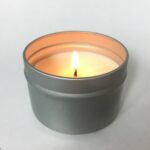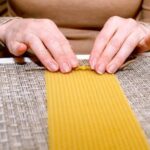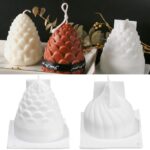Are you wondering how to clean equipment after candle making? Cleaning your tools and supplies properly is essential for maintaining the quality of your equipment and ensuring successful future candle-making endeavors.
Residue from wax, wicks, and other materials can build up over time, so it’s important to develop a routine for cleaning your equipment after each use. In this article, we will discuss the importance of cleaning equipment after candle making and provide you with a step-by-step guide on how to effectively clean various tools and supplies used in the candle-making process.
When it comes to creating beautiful candles, keeping your equipment clean is just as important as choosing the right ingredients. Neglecting proper cleaning practices can lead to contamination of your supplies and impact the quality of your candles. Additionally, regular maintenance and cleaning of your equipment can help extend their lifespan, saving you time and money in the long run.
In the following sections, we will explore the tools and supplies needed for cleaning equipment after candle making. We will also provide a detailed guide on removing wax residue from melting pots, pouring pitchers, wick trimmers, scissors, thermometers, stirring utensils, molds, containers, as well as tips for cleaning up any spills or drips.
By following these best practices for maintaining cleanliness in your candle-making workspace, you can help ensure that every batch of candles you create is of exceptional quality.
Tools and Supplies Needed for Cleaning Equipment
After completing a candle-making session, it is crucial to thoroughly clean the equipment used to ensure its longevity and maintain its effectiveness for future use. Properly cleaning the tools and supplies used in candle making will also help prevent cross-contamination of scents or colors in future projects. To effectively clean candle making equipment, you will need the following tools and supplies:
1. Hot Water: Use hot water from the tap to help melt and remove any wax residue from your equipment.
2. Dish Soap: A mild dish soap will help break down any remaining wax and lift it off the surfaces of your tools.
3. Soft Cloth or Sponge: These are great for gently scrubbing away any leftover wax or soot without scratching your tools.
4. Metal Scraper: A metal scraper can be used to remove excess dried wax from pouring pitchers, melting pots, or stirring utensils.
5. Baking Soda: Baking soda is an effective natural abrasive that can aid in removing stubborn wax deposits.
6. Vinegar: White vinegar can be used to break down grease and grime, especially on thermometers or wick trimmers.
7. Rubbing Alcohol: Rubbing alcohol is great for dissolving wax residue and disinfecting your tools at the same time.
Now that you know what tools and supplies you’ll need, let’s dive into a step-by-step guide on how to effectively clean each piece of equipment after candle making using these items:
– Start by collecting all your dirty candle-making equipment in one place.
– Fill a sink or basin with hot water, adding a few squirts of dish soap.
– Place your stirring utensils, pouring pitchers, melting pots, and other washable equipment into the soapy water.
– Let them soak for 10-15 minutes to soften any remaining wax residue.
– After soaking, use a soft cloth or sponge to scrub away any softened wax.
– For stubborn wax deposits, use a metal scraper or sprinkle some baking soda onto the affected areas before scrubbing.
– Rinse each item under hot running water to remove all traces of soap and debris.
– Dry each item completely with a clean towel before storing it away for future use.
By following these steps using the mentioned tools and supplies needed for cleaning equipment after candle making,you’ll be able to keep your supplies in top condition,reducing costs associated with replacement & ensuring successful future projects.
Step-by-Step Guide on Cleaning Wax Residue From Melting Pots and Pouring Pitchers
Cleaning wax residue from melting pots and pouring pitchers is an essential part of the candle making process. Failure to properly clean these tools can result in contamination of future batches, affecting the quality and appearance of your candles. In this section, we will provide a step-by-step guide on how to effectively clean wax residue from melting pots and pouring pitchers.
Gather Your Supplies
Before you begin cleaning, it’s important to gather the necessary supplies. You will need hot water, dish soap, a sponge or scrub brush, paper towels, and a heat-resistant scraper or spatula for scraping off any stubborn wax residue.
Step 1: Scrape Off Excess Wax
Start by using a heat-resistant scraper or spatula to remove any excess wax from the melting pot or pouring pitcher. Be gentle to avoid scratching the surface of the container.
Step 2: Wash With Hot Soapy Water
Next, fill the melting pot or pouring pitcher with hot soapy water and let it sit for a few minutes to help loosen any remaining wax residue. Use a sponge or scrub brush to thoroughly wash the interior and exterior of the container.
Step 3: Rinse and Dry
Once all the wax residue has been removed, rinse the melting pot or pouring pitcher with clean water to ensure that all soap and debris are completely washed away. Use paper towels to dry the containers thoroughly before storing them for future use.
By following these step-by-step instructions on how to clean wax residue from melting pots and pouring pitchers, you can ensure that your equipment remains in good condition for future candle making projects. Regular cleaning and maintenance will also contribute to the overall success and quality of your candle creations.
Tips for Safely Removing Dried Wax From Wick Trimmers and Scissors
Using Heat to Loosen Dried Wax
After candle making, dried wax can often be found on wick trimmers and scissors. One way to safely remove this dried wax is by using heat. To do this, use a hairdryer set on low heat or a heat gun to warm up the dried wax. Be careful not to hold the heat source too close to the metal parts of the tools to avoid any damage. The gentle heat will soften the wax, making it easier to wipe away.
Applying Oil for Easy Removal
Another effective method for safely removing dried wax from wick trimmers and scissors is by applying oil. You can use any type of cooking oil or mineral oil for this purpose. Simply soak a cloth or cotton ball in the oil and gently rub it over the areas with dried wax. The oil helps to break down the wax, making it easier to wipe off.
Cleaning With Dish Soap and Warm Water
Once you have used either the heat or oil method to loosen the dried wax, you can then clean the wick trimmers and scissors with dish soap and warm water. Use a soft-bristled brush or cloth to scrub away any remaining residue. Make sure to thoroughly dry the tools after cleaning to prevent any rusting. Properly cleaned wick trimmers and scissors are essential for ensuring they function properly during your next candle making session.
Best Practices for Cleaning & Maintaining Thermometers and Stirring Utensils
When it comes to making candles, cleaning and maintaining your equipment is essential for ensuring success in future candle making projects. This includes taking proper care of thermometers and stirring utensils. Neglecting cleaning can lead to cross-contamination of scents, colors, and residues, which can ruin the quality of your candles.
To clean thermometers and stirring utensils after candle making, you will need some basic supplies such as hot water, dish soap, a soft cloth or sponge, and rubbing alcohol. Begin by wiping away any excess wax from the thermometer or stirring utensils using the soft cloth. Then, wash them with warm soapy water to remove any leftover wax residue. After washing, rinse thoroughly and wipe them down with rubbing alcohol to disinfect.
It’s important to note that different types of thermometers require specific cleaning methods. For example, if you have a glass thermometer, avoid using extreme temperatures when cleaning as this can cause it to break. Similarly, metal stirring utensils should be dried immediately after washing to prevent rusting. By following these best practices for cleaning and maintaining thermometers and stirring utensils, you can ensure that your equipment remains in good condition for future use.
| Equipment | Cleaning Methods |
|---|---|
| Thermometers | Wipe with soft cloth; wash with warm soapy water; rinse thoroughly; wipe with rubbing alcohol |
| Stirring Utensils | Wash with warm soapy water; dry immediately after washing |
How to Properly Clean and Store Candle Molds and Containers
After candle making, properly cleaning and storing your candle molds and containers is essential to ensure the success of future candle making projects. Residual wax left behind in molds and containers can affect the quality of your next batch of candles, so it’s crucial to thoroughly clean and store these items after each use.
To clean your candle molds and containers, you will need some basic tools and supplies. These include hot water, dish soap, a sponge or soft cloth, and a towel for drying. For stubborn wax residue, you may also need a plastic scraper or a butter knife to gently remove the leftover wax.
Begin by heating some hot water and adding dish soap to create a soapy solution. Use this solution to wash the molds and containers thoroughly with a sponge or soft cloth, ensuring that all wax residue is removed. For any stubborn wax that may be stuck on the surfaces, gently scrape it off using a plastic scraper or butter knife. Once everything is clean, rinse the molds and containers with hot water and dry them with a towel before storing.
When it comes to storing your cleaned candle molds and containers, make sure they are completely dry before putting them away. Store them in a cool, dry place where they won’t be exposed to dust or other contaminants that could affect the quality of your candles in the future. By following these simple steps for cleaning and storing your candle molds and containers, you’ll be better prepared for successful candle making endeavors in the future.
Tips for Cleaning Up Any Spills or Drips
Spills and drips are inevitable when making candles, but it’s important to clean them up properly to maintain a safe and tidy workspace. Here are some tips for cleaning up any spills or drips:
1. Scrape off excess wax: Use a butter knife or similar tool to gently scrape off any excess wax from the surface where the spill occurred. Be careful not to damage the surface or push the wax further into the material.
2. Use hot water and soap: For smaller spills on hard surfaces, such as countertops or floors, use hot water and dish soap to clean up the wax. Let the soap sit for a few minutes to help break down the wax before wiping it away with a cloth.
3. Absorb larger spills: If you have a larger spill on carpet or fabric, start by using paper towels to blot up as much of the melted wax as possible. Then use an iron on a low setting and lay a paper towel over the affected area. Iron over the paper towel to gently melt and absorb the remaining wax.
Remember that cleaning up spilled candle wax requires patience and care, but with these tips, you can effectively remove any unwanted messes from your workspace.
Final Thoughts on the Importance of Properly Cleaning Equipment for Future Candle Making Success
In conclusion, it is crucial to emphasize the significance of properly cleaning equipment after candle making for future success in this craft. Neglecting to clean your tools and supplies thoroughly can not only affect the quality of your next batch of candles but also pose potential safety hazards. By following a systematic approach and using the right tools and supplies, you can ensure that your equipment remains in good condition for optimal use in future candle making endeavors.
One of the key takeaways from this guide is the importance of investing in high-quality cleaning supplies such as specialized wax removers, brushes, and cleaning cloths. Additionally, being diligent about removing wax residue from melting pots, pouring pitchers, wick trimmers and scissors can prevent potential cross-contamination between different fragrance oils or dyes used in your candles. This attention to detail can significantly impact the quality and consistency of your candle products.
Moreover, proper maintenance of thermometers, stirring utensils, molds, containers, and addressing any spills or drips promptly are essential for ensuring that your candle making process runs smoothly. By incorporating these best practices into your routine cleaning regimen, you are setting yourself up for success in future candle making projects. Remember that cleaning equipment after candle making is not just a chore; it is an investment in the quality and safety of your craft.
Frequently Asked Questions
How Do You Clean Tools After Candle Making?
After candle making, it’s important to clean your tools thoroughly to remove any wax residue. One method is to wipe the tools with a paper towel or cloth while the wax is still warm and pliable.
Then, you can wash the tools with dish soap and hot water to remove any remaining wax. It’s important to make sure the tools are completely dry before storing them.
How Do You Remove Candle Wax From Steel Utensils?
Removing candle wax from steel utensils can be done by placing the utensils in the freezer for about 30 minutes to an hour. Once the wax is frozen, it becomes brittle and can be easily chipped off of the utensils using a butter knife or credit card.
Any remaining residue can be wiped away with a cloth soaked in hot, soapy water.
How Do You Clean Candle Residue?
Cleaning candle residue from surfaces or containers typically involves scraping off any excess wax with a plastic scraper or credit card. Then, you can use a mixture of hot water and dish soap to clean the area, followed by wiping it down with a clean cloth.
For tougher residue, rubbing alcohol or vinegar can be used as solvents to dissolve the wax before cleaning with soap and water.

Welcome to my candle making blog! In this blog, I will be sharing my tips and tricks for making candles. I will also be sharing some of my favorite recipes.





